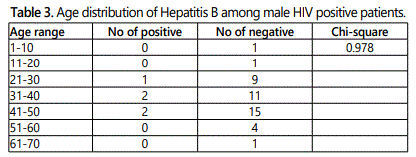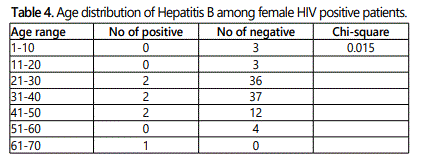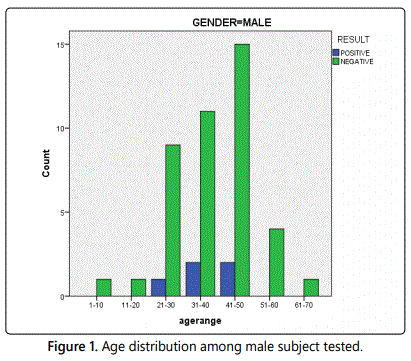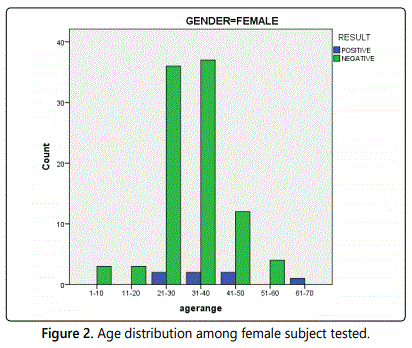Research Article
Prevalence of Hepatitis B Virus among HIV-Positive Patients attending PEPFAR Clinic at Maiduguri Specialist Hospital
1WHO National Polio/ITD Laboratory, University of Maiduguri Teaching Hospital, Maiduguri, Nigeria
2Department of Medical Laboratory Science, College of Medical Sciences, University of Maiduguri, Maiduguri, Nigeria
3Department of Veterinary Microbiology, University of Maiduguri, Maiduguri, Nigeria
*Corresponding author: Muhammad Talle, WHO National Polio/ITD Laboratory, University of Maiduguri Teaching Hospital, Maiduguri, Nigeria, E-mail: muhammadt6@gmail.com
Received: March 12, 2019 Accepted: October 7, 2019 Published: October 15, 2019
Citation: Talle M, Samaila H, Hamidu IM, et al. Prevalence of Hepatitis B Virus among HIV-Positive Patients attending PEPFAR Clinic at Maiduguri Specialist Hospital. Madridge J Mol Biol. 2019; 1(1): 23-25. doi: 10.18689/mjmb-1000104/a>
Copyright: © 2019 The Author(s). This work is licensed under a Creative Commons Attribution 4.0 International License, which permits unrestricted use, distribution, and reproduction in any medium, provided the original work is properly cited.
Abstract
Hepatitis B infection among HIV patients continue to be on the rise with frequent complications especially in children having greater risk of vertical transmission of the virus from the mothers during pregnancy period. The aim of this study is to investigate the prevalence of Hepatitis B among HIV positive patients attending PEPFAR clinic of state specialist hospital, Maiduguri. A total of 150(n=150) were enrolled in this study and their consent were sought. The patients sample (3 ml venous blood) were aseptically collected and serum separated. Serum was tested using one step rapid chromatographic strip for HBsAg in accordance to manufacturerʼs instructions. Out of the total sample, 12 (8%) were found positive for HBsAg. The highest prevalence was recorded among the age group of 31-40 years, 47(68.0) male were tested and 102(31.3%) female were tested. Hence, avoid body contact with blood and blood products as well as adherence to basic laboratory safety procedures has been stressed.
Keywords: Prevalence; Hepatitis B virus; HIV.
Introduction
Hepatitis is an inflammation of the liver due to the presence of inflammatory cells in the infected tissue. Torbenson and Thomas [1] reported that about 360 millions of people are globally suffering from the chronic forms of hepatitis B virus infection. Baba et al. [2] also reported that prolonged forms of hepatitis B, including active and inactive can lead to major complications such as hepatocellular carcinoma (HCC) and liver cirrhosis. Hepatitis B infection also serves as opportunistic infection in congenital, acquired immunodeficiency and also following immunosuppressive therapy. HBV co-infection is one of the most frequent complications in HIV/AIDs patient due to similarity in their mode of transmission of these two viruses which results to an increase in the incidence rate of co-infection [3]. It has been reported that reduction in the CD4 cells count below 200 cells/ml, predisposes HIV positive patients to various opportunistic pathogens which result to re-activation of HBV infection and other related complications [4].
Viral hepatitis B infection like many other blood borne pathogens is transmitted via unscreened blood transfusion and blood products, used of unsterilized medical or dental equipments in countries where equipments are not adequately sterilized, intra veinous drug users and body piercing using unsterile equipment [5].
Study population
The ethical clearance for the study was obtained from the research and ethics committee of the specialist hospital Maiduguri, Borno state before commencement of the work. The entire participants were informed about the purpose of the study. Blood samples were collected from the patients that come for their drug collection and routine check-up at Pepfar clinic of state specialist hospital Maiduguri Borno state. About 150 samples were collected for the research project.
Materials and Methods
Sample collection
The blood samples were collected by vein puncture between 9 am-12 am, 150 patients who were positive for HIV infection was bled and were tested for HBsAg. The blood samples were spun at 3000 revolution per 5 minutes to separate the plasma from the whole blood and the plasma were separated and stored in cryovals and kept in freezer at -20°C, then hepatitis B surface antigen test was carried out.
Test procedure
The method was carried out by using ABON & SPODEX KIT OF ONE STEP HEPATITIS B SURFACE ANTIGEN TEST STRIP (serum/plasma) package insert.
The HBsAg one step hepatitis B surface antigen test strip (serum/plasma) was performed using either serum or plasma. The strip was brought to room temperature prior to the testing (about 15-30°C). The strip was removed from the sealed foil pouch and it was as soon as possible. Best result was obtained immediately after opening the foil pouch. For serum or plasma specimen, with arrow pointing toward the specimen, it was inserted for at least 10-15 seconds without passing the maximum line. The test strip was placed on a non-absorbent flat surface; the timer was stared and observed for the color line(s) to appear. The result was read at 15 minutes.
Note: A low HBsAg concentration might result in a weak line appearing in the test region (T) after an extended period of time; therefore, do not interpret the result after 30 minutes.
Results
A total number of 150 patients who are HIV positive screened for the presence of HBsAg by using rapid strip method and below are the results obtained. The result of the study reveals the prevalence of HBsAG and infection was also remarkable different in both the study cohorts.
The table 1 revealed the gender difference among the male and the female individual tested. The results showed that 5(3.3%) of male are positive, 42(28%) are negative, while 7(4.76%) tested are positive female, 95(63.33%) are HBsAg negative out of the 150 HIV individual tested. There was no significant difference between the age and HBV status of HIV positive patient with female gender being associated with HBV (p=0.701).

The results in table 2 showed marital status of the patients. The total number of patient that are married were 116(77.3%) and 11(7.3%) are positive, 105(70%) are negative. For patients that are not married (single) are 34(22.7%) and 1(0.7%) is positive, 33(22%) are HBsAg negative.

The table 3 showed the age range distribution between both sexes. The age group of 41-50 has high number of positive, but there was no significant difference between age range and HBV infection status among male HIV positive patients.

The table 4 showed the age range of female, most of the patients were negative and there was significant difference between the age and HBV status among female HIV positive patients. Illustrations were shown below in figures 1 and 2 respectively.



Discussion
Hepatitis is an inflammation of the liver characterized by the presence of inflammatory cells in the tissue of the organ, recent reports states that 360 millions of people are globally suffering from the chronic forms of hepatitis B virus infection (CHB) [1]. One of the frequent complications in HIV positive patients is HBV co-infection due to the common method of transmission of these two viruses, the incidence rate of co-infection is increasing [3]. It has been established that following reduction in the CD4 positive cells count to lower than 200 cells/ml, the immune system of HIV positive patients fails to develop an adequate immune response against microbial agents and as a result re-activation of HBV infection and its related complications will occur [4]. This study was carried out to determine the prevalence of hepatitis B virus among HIV patients attending state specialist hospital Maiduguri, Borno state by rapid determined strip.
The overall prevalence of HBsAg positive in population study was 100% from the north central Nigeria, reported a HBsAg prevalence rate of 10.7%.
Based on the present study, the prevalence of HBsAg among HIV positive patients are 8 to 92 percent respectively. According to the study, prevalence occurred highest at the age range of 31 to 40(34%). The highest occurrence base on gender also differs and is highest in female with 4.76% and 3.3% in male. The number of those tested based on marital status i.e. married are 116(77.3%) and 11(7.3%) are positive HBV while for those that are single have 34(22.7%) and 1(0.7%) is positive. The there was significant difference between age and HBV infection status among the female subjects of HIV patients attending pepfar clinic of state specialist hospital Maiduguri Borno state.
Table 4 shows no significant difference between the age range of male and HBV infection status with HIV positive infection. Table 2 shows that there is no significant difference between the age and HBV status of HIV positive patients. HIV-HBV co-infection is worldwide frequent. According to the recent findings of this study, the incidence of HIV/HBV co infection in the American and European countries are higher (30.4%) than the Asia and Africa (28.4%) population which may attract more attention in this regard. Finally, the higher prevalence of HBV in HIV positive patients may be described to the suppression of immune responses in HIV positive patients against HBV infection rather than to the other background reasons. Further studies and attention are warranted in this aspect for planning of more effective prophylactic or therapeutic strategies [6,7].
Conclusion
Findings from this study revealed the highest prevalence occurred at the age range of 31 to 40(34%). Also it was highest in female with 4.76% and 3.3% in male. The number of those tested based on marital status i.e. married were 116(77.3%) and 11(7.3%) are positive HBV while for those that are single have 34(22.7%) and 1(0.7%) is positive.
Recommendation
Base on the findings from this study, it is recommended that the general public should be: Immunised against HbsAg and there should be mass mobilization on its mode of transmission, prevention and control.
References
- Torbenson M, Thomas. DL. Occult hepatitis B. Lancet Infect Dis. 2002; 2(8): 479-486.
- Chen JJ, Yu CB, Du WB, Li LJ. Prevalence of hepatitis B and C in HIVinfected patients: a meta-analysis. Hepatobiliary Pancreat Dis Int. 2011; 10(2): 122-127. doi: 10.1016/S1499-3872(11)60020-9
- Cao GW. Clinical relevance and public health significance of hepatitis B virus genomic variations. World J Gastroenterol. 2009; 15(46): 5761-5769. doi: 10.3748/wjg.15.5761
- De Milito A. B lymphocyte dysfunctions in HIV infection. Curr HIV Res. 2(1): 11-21.
- Marité B, Montalvo MC, Rodríguez Lde L, et al. Occult hepatitis B in Cuban HIV patients. MEDICC Rev. 2011; 13(2): 32-37.
- Ejele OA, Nwauche CA, Erhabor O. Seroprevalence of hepatitis C virus in the Niger Delta of Nigeria. Niger Postgrad Med J. 2006; 13(2): 103-106.


